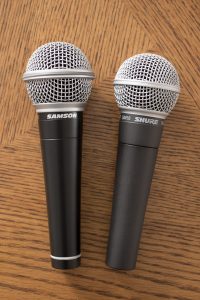Samson R21
I have a gig to record sound for a short film. This one is unusual in that all of the actors will be speaking into visible microphones (a PA system in an auditorium). I’ve been asked to supply microphones that will be used simultaneously as props and to record the dialog. I had a few handheld dynamic vocal mics, but none that match. In an effort to avoid a mishmash of microphones, I figured I would buy a second and perhaps a third Shure SM58. However, I stumbled across the Samson R21. After reading and listening to some reviews, I decided to buy some and give them a try. I will admit, this decision was motivated by cost.

When they arrived, I made some recordings for a side-by-side comparison. I was surprised how similar they sounded. I’ve compared other handheld dynamic vocal mics, and they have all had very distinguishable personalities. Even the SM57 sounds different from the SM58, even though internally they are basically the same microphone. However, the R21 sounds almost identical to the SM58. Clearly, Samson made an effort to duplicate the sound, and they have succeeded quite brilliantly. In a side-by-side comparison, I wouldn’t be able to tell you which one is which — with one exception: plosives.
Both microphones have a built-in windscreen / pop filter. The one on the SM58 works reasonably well. The one on the R21 does not. The R21 picks up an enormous amount of plosive, and it rumbles quite a bit just from breathing. And this was an in-studio speaking test; imagine a heavy-breathing performer on stage. I assume the difference is mainly caused by the distance from the inside of the windscreen to the front of the microphone element. The R21’s element is right up inside the windscreen, while the SM58’s is set low, in basically the middle of the cage. I was able to record with the microphone offset to the side, out of line with my plosives, and produced much better results. However, I can’t rely on this technique for my application. For me, this one difference is a deal-breaker.
It seems that most people don’t realize that the Samson R21S is a different model of the same microphone, but with an On/Off switch. A switch may sound like a good idea, but in practice it only creates trouble. Users are always switching it off, which then confounds the next person to pick up the microphone. In such situations, the audio engineer is helpless to assist, except to gesticulate in an attention-grabbing but somehow non-insulting manner that communicates the necessity of having the mic switched on. The only handheld microphone I own with a switch is the Sennheiser MD 431 II, which can be mechanically disabled.
Aside from all that, the existing reviews seem to be fairly complete. The R21 weighs much less than an SM58. You shouldn’t expect the R21 to survive being used as a hammer or dropped for effect.